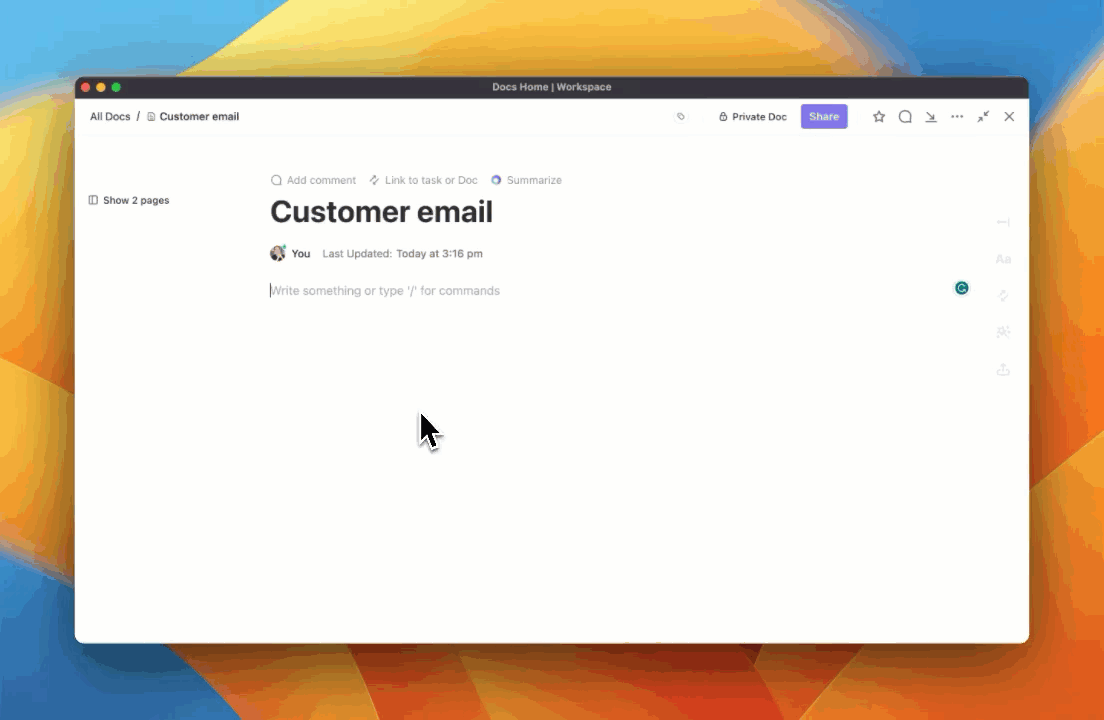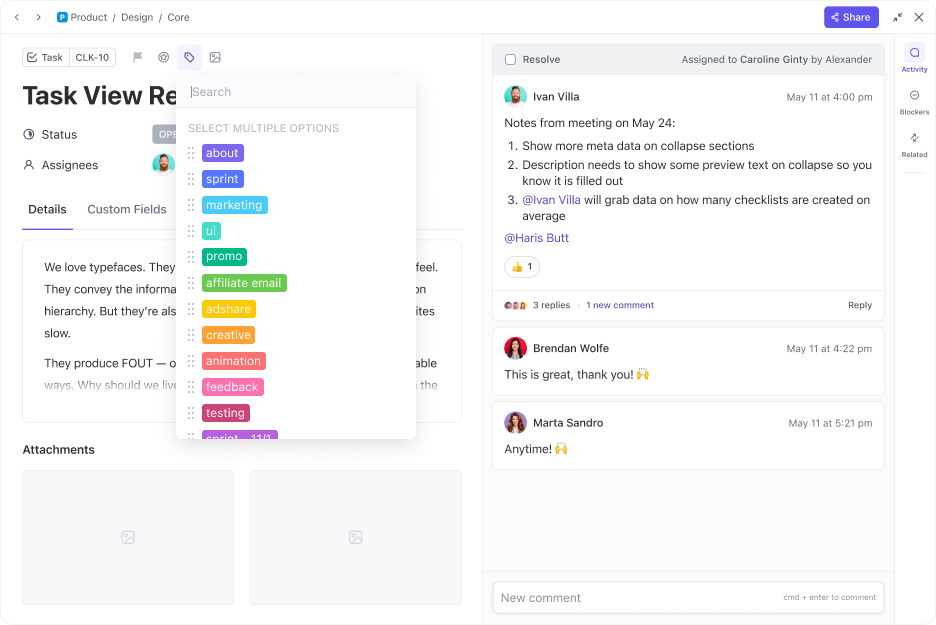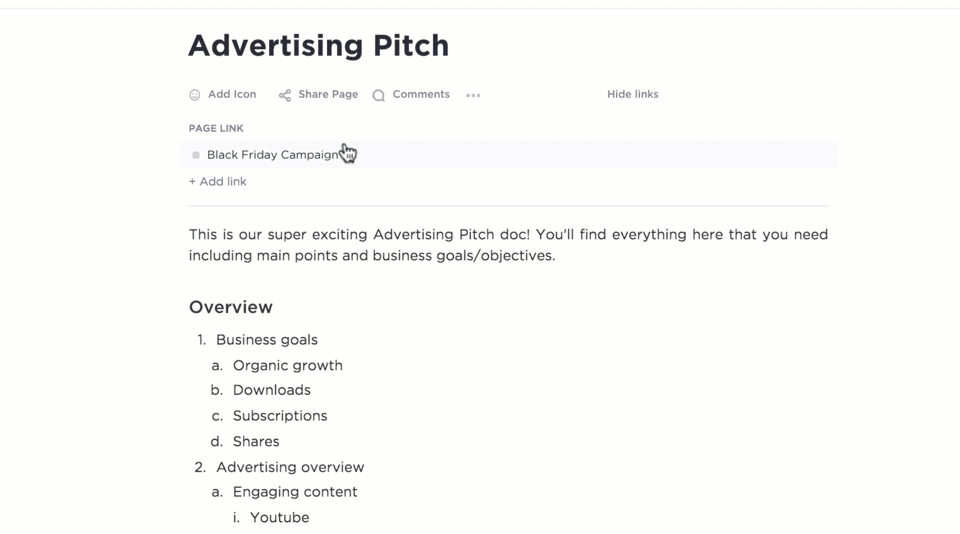هل تساءلت يومًا ما الذي يفكر فيه عملاؤك حقًا؟
يمكن أن تكون ملاحظاتهم منجم ذهب من الأفكار - إذا كنت تعرف كيفية إدارتها بشكل جيد.
إن إعداد نظام فعال لإدارة ملاحظات العملاء ليس معقدًا كما يبدو. في الواقع، باستخدام الأداة الصحيحة لإدارة ملاحظات العملاء، يمكنك التوقف عن تخمين ما يريده عملاؤك والبدء في تقديم ما يحتاجونه بالضبط.
دعنا نتعمق في كيفية جمع ملاحظات العملاء القابلة للتنفيذ، واكتساب رؤى قيمة حول احتياجات المستخدمين وتفضيلاتهم، واتخاذ قرارات مستنيرة بشأن المنتجات والأعمال.
ما هي إدارة التغذية الراجعة؟
إدارة الملاحظات هي العملية المنهجية لجمع الملاحظات من مختلف أصحاب المصلحة الداخليين والخارجيين وتحليلها والاستجابة لها
تتضمن هذه العملية المكونة من ثلاث خطوات في المقام الأول
- تحديد وإنشاء قنوات مختلفة ملائمة لجمع التغذية الراجعة
- تحليل التغذية الراجعة وتوحيد إجراءات العمل عليها
- توليد رؤى قابلة للتنفيذ لدفع التغيير الإيجابي والنمو المؤسسي
إن إدارة ملاحظات العملاء بفعالية أمر بالغ الأهمية لتحسين أعمالك. دعنا نفهم السبب.
لماذا تعتبر إدارة ملاحظات العملاء مهمة؟
تخبرك ملاحظات العملاء بما ينجح وما لا ينجح وكيفية التحسين! تساعدك إدارة ملاحظات العملاء بمهارة على فهم ما يفكر فيه عملاؤك وتمنحك الأدوات اللازمة لتصحيح الأمور. فهي تتيح لك:
- تحسين جودة المنتج: من خلال فهم ما يعجب العملاء أو ما لا يعجبهم، يمكنك إجراء تحسينات مستنيرة على المنتجات أو الخدمات والتأكد من أنها تلبي احتياجات العملاء وتوقعاتهم
- تعزيز رضا العملاء: إن الاستماع الفعال إلى ملاحظات العملاء والتصرف بناءً عليها يُظهر للعملاء أن آراءهم تحظى بالتقدير، مما يؤدي إلى زيادة رضاهم وولائهم
- تحديد مجالات التحسين: تسلط الملاحظات الضوء على مجالات محددة قد تكون مقصرة فيها، مما يسمح بإجراء تحسينات مستهدفة يمكن أن تمنع تفاقم المشكلات
- دفع عجلة الابتكار: يمكن أن تكشف رؤى العملاء عن فرص وأفكار جديدة لمنتجات أو ميزات يمكن أن تمنحك ميزة تنافسية
- تعزيز العلاقات: إن المشاركة المنتظمة مع العملاء من خلال قنوات التغذية الراجعة تعزز العلاقة وتزيد من قوة العلاقة بينك وبينهمالتصاق العملاء
- زيادة الاحتفاظ بالعملاء: معالجة الملاحظات بشكل سريع وفعال يمكن أن يقلل من تراجع العملاء عن طريق حل المشكلات وتعزيز الثقة في العلامة التجارية
حقيقة ممتعة: 12.8% من جميع العملاء، في المتوسط، يشتكي في جميع الصناعات.
أنواع شكاوى العملاء
قد يكون فهم ملاحظات العملاء أشبه ما يكون بتجميع أحجية. هناك العديد من الطرق لجمع وتحليل ملاحظات العملاء، ولكنها تنقسم بشكل عام إلى فئتين رئيسيتين: التعليقات المباشرة والتعليقات غير المباشرة.
- الملاحظات المباشرة يتم جمعها من العملاء من خلال الاستبيانات والمقابلات ونماذج الملاحظات، حيث تقدم آراء واضحة ومحددة مباشرة من المصدر
- التغذية الراجعة غير المباشرة، من ناحية أخرى، تُستمد من مراقبة سلوك العملاء، مثل أنماط الشراء أو بيانات الاستخدام. وهي توفر رؤى قيمة حول العميل دون أن يصرح العميل بآرائه صراحةً
كلا النوعين ضروريان لفهم شامل لتجارب العملاء وتفضيلاتهم.
## كيفية الحصول على آراء العملاء
من خلال اختيار القنوات المناسبة لجمع آراء العملاء، يمكنك أن تفهم بشكل أفضل كيف ينظر الناس إلى منتجاتك أو خدماتك وتسلط الضوء على مجالات التحسين.
للتأكد من أنك تجمع رؤى قيّمة، دعنا نستكشف بعض القنوات الفعالة للحصول على آراء العملاء.
6 قنوات فعالة للغاية للحصول على ملاحظات العملاء
مع وضع ذلك في الاعتبار، دعنا نتعمق في ست أدوات قوية للحصول على ملاحظات العملاء - وكيف ClickUp يدعم هذه الجهود:
### استبيانات البريد الإلكتروني أو الاستبيانات داخل التطبيق

اكتب رسائل البريد الإلكتروني بشكل أسرع باستخدام ClickUp Brain وشجع القراء على المشاركة
عندما يتعلق الأمر بالتغذية الراجعة المباشرة، فإن القليل من الأشياء تتفوق على الاستبيانات أو الاستبيانات.
الاستطلاعات داخل التطبيق أو الاستبيانات المرسلة عبر قنوات التواصل مثل البريد الإلكتروني تجذب اهتمام العملاء أثناء استخدامهم لمنتجك أو برنامجك. وتتيح لهم هذه المشاركة مشاركة تعليقاتهم ذات الصلة وفي الوقت المناسب.
يمكن إرسال الاستبيانات أو الاستبيانات عبر البريد الإلكتروني استجابةً لإجراءات العملاء، مثل التخلي عن عربة التسوق أو تباطؤ معدلات الاستخدام.
ميزة ClickUp: اختر من بين مجموعة من الاستبيانات المعدة مسبقًا قوالب نماذج الملاحظات أو إنشاء استبيانات واستبيانات مخصصة لجمع ملاحظات العملاء. استخدم أتمتة ClickUp لأتمتة تحليل الردود. اربط الملاحظات القابلة للتنفيذ بمهام ذات أولويات مختلفة.
مقابلات العملاء
تكشف مقابلات العملاء وملاحظات المستخدمين عن رؤى تفصيلية حول كيفية استخدام العملاء لمنتجك وتفاعلهم معه. توفر مثل هذه التفاعلات المباشرة مع العملاء نافذة على نقاط ألم العملاء وتفضيلاتهم وتجربة العميل بشكل عام.
ميزة ميزة ClickUp: إن عرض التقويم على ClickUp يتيح لك جدولة مقابلات العملاء وتتبعها. عند استخدامه مع ClickUp Notepad يتيح لك ذلك التقاط ملاحظات العملاء على الفور.
الإصغاء لوسائل التواصل الاجتماعي
عادةً ما يستخدم العملاء وسائل التواصل الاجتماعي لمشاركة احتياجاتهم وملاحظاتهم وآرائهم ومشاعرهم حول منتجك أو خدمتك. ومن شأن الاستجابة السريعة والتدخل السريع على هذه المنصات العامة أن يعزز صورة العلامة التجارية ويوحي بالثقة.
ميزة ClickUp: ادمج أدوات مراقبة وسائل التواصل الاجتماعي مثل Hootsuite أو Brandwatch مع ClickUp لتمكين فرق إدارة وسائل التواصل الاجتماعي لديك. بالإضافة إلى تحويل الملاحظات إلى مهام، يمكن لفرق SMM الاستفادة من وحدة كاتب الذكاء الاصطناعي في ClickUp Brain لصياغة رسائل مخصصة ذات صلة بالموقف، مثل الاعتذار عن سوء الخدمة ردًا على التعليقات السلبية للسيطرة على الأضرار الفورية.
اختبار المستخدم
ينطوي اختبار المستخدم على جمع ملاحظات العملاء أثناء تفاعلهم مع ميزة أو منتج جديد قبل إصداره للجمهور. تساعد هذه المنهجية في تحديد مشكلات قابلية الاستخدام وتضمن أن المنتج أو الخدمة تتوافق مع توقعات العملاء.
وهي عبارة عن استطلاعات مستهدفة يتم فيها مكافأة ولاء العملاء بالوصول الحصري إلى الميزات والتحديثات الجديدة.
ميزة ClickUp Advantage: استخدام ClickUp كإدارة علاقات العملاء لتحديد عملائك ذوي القيمة العالية وإشراكهم في تمارين اختبار المستخدم. اربط بين قصص المستخدمين الخاصة بهم وعلاقاتهم مع العملاء لتحليل المشاعر المتعمقة وأولوية التعليقات.
أدوات التعليقات
قم بتضمين أدوات الملاحظات داخل برنامجك أو موقعك الإلكتروني لجمع الملاحظات بشكل تلقائي. يمكن أن يكون ذلك بعد إتمامهم عملية شراء أو إنجاز مهم. تتيح هذه الأدوات للعملاء مشاركة آرائهم وتجاربهم في الوقت الفعلي.
ميزة ClickUp: توجيه مدخلات الأداة إلى أتمتة النقر فوق لالتقاط بيانات ملاحظات العملاء وتصنيفها وتحليلها. استنادًا إلى النتائج، يمكن لـ ClickUp تحويل الملاحظات إلى مهمة أو تصعيدها للمراجعة البشرية.
تفاعلات دعم العملاء
تُعد تفاعلات دعم العملاء، سواء كانت تذاكر أو رسائل الدردشة المباشرة، منجمًا ذهبيًا لتعليقات العملاء. يسلط تحليل محادثات دعم العملاء الضوء على المشكلات المتكررة، وطلبات الميزات، والمجالات التي لا يفي فيها المنتج أو الخدمة بالغرض.
ميزة ClickUp: قم بدمج ClickUp مع برنامج مكتب المساعدة الخاص بك وقم بتجميع ملاحظات دعم العملاء في مستندات ClickUp . سيتيح لك ذلك إنشاء المهام تلقائياً والمتابعة مع العملاء، مما يضمن لك التعامل مع كل طلب دعم بشكل فوري وفعال.
## كيفية إعداد نظام إدارة الملاحظات
يتطلب تطوير نظام منظم لإدارة ملاحظات العملاء إطار عمل قوي لضمان التصرف بناءً على كل جزء معقول من الملاحظات المعقولة ودفع التحسينات.
إليك كيفية إتقان ذلك:
جمع ملاحظات العملاء
اجمع ملاحظات العملاء من خلال نماذج جيدة التصميم تتكامل مع برنامجك أو موقعك الإلكتروني أو تطبيقك. ستحتاج إلى أداة لإدارة ملاحظات العملاء لالتقاط مدخلات العملاء.
يمكنك إنشاء استبيانات مخصصة داخل النظام البيئي لإدارة المشروع باستخدام نماذج ClickUp . يتيح ذلك تدفق ملاحظات العملاء مباشرةً إلى سير عملك. بدلاً من ذلك، هناك نماذج أو قوالب جوجل التي يمكن تخصيصها لتناسب الإعدادات المختلفة.

_التقاط ملاحظات العملاء باستخدام نماذج ClickUp القابلة للتخصيص بدرجة كبيرة
يجب أن تنتشر نقاط جمع ملاحظات العملاء هذه عبر المراحل المختلفة من رحلة العميل - ما قبل الشراء/التسجيل، وما بعد الشراء/التسجيل، والتفاعل بعد الدعم، وطرح التحديثات الرئيسية، وما إلى ذلك. من خلال القيام بذلك، يمكنك الحصول على مجموعة واسعة من ملاحظات العملاء من مختلف المراحل، مما يؤدي إلى استجابات أسرع واتخاذ قرارات أكثر استنارة.
تنظيم التغذية الراجعة
بعد جمع ملاحظات العملاء، تتمثل المهمة التالية في تنظيم بيانات الاستبيان لتوحيد المدخلات من مختلف القنوات. يجب أيضًا توحيد هذه البيانات، حيث قد تكون التغذية الراجعة متاحة بتنسيقات مختلفة.
قم بإنشاء نظام واضح لتصنيف ملاحظات العملاء وترتيب أولوياتها لضمان عدم انزلاق أي شيء من خلال الشقوق. ابدأ بتجميع ملاحظات المستخدمين في فئات منطقية - على سبيل المثال; البرمجيات الفرق قد تقسم ملاحظات العملاء إلى طلبات الميزات، ومشكلات قابلية الاستخدام، وتحسينات التصميم، وما إلى ذلك. من خلال تجميع الملاحظات، يمكنك تحديد الملاحظات ذات الأولوية القصوى ومعالجتها أولاً.
يوفر ClickUp العديد من الميزات التنظيمية لفرز الملاحظات وتحديد أولوياتها، مثل علامات مهام ClickUp و مستويات الأولوية . بالإضافة إلى ذلك، توفر القوائم وطرق عرض اللوحة للمستخدمين التحكم في كيفية رغبتهم في تتبع الملاحظات وإدارتها.

إضافة وسوم إلى الملاحظات لفرزها وتنظيمها
تحليل الملاحظات
تحليل ملاحظات العملاء هو المكان الذي تترجم فيه المدخلات الأولية إلى رؤى قابلة للتنفيذ. أثناء قيامك تحليل ملاحظات العملاء ستلاحظ الاتجاهات أو الأنماط ونقاط الألم المتكررة وفرص التحسين. الهدف هنا هو استخلاص ارتباطات منطقية لإثراء عملية تطوير المنتج والقرارات التجارية.
نظرًا لأن لديك بالفعل ملاحظات العملاء في شكل منظم، ما عليك سوى توصيلها بـ لوحة التحكم وأدوات إعداد التقارير في ClickUp لتصور جميع البيانات. ستسهل تقنيات تصور البيانات هذه من اكتشاف اتجاهات التغذية الراجعة والتنبؤ بتأثير مشكلات أو قرارات محددة.
بالإضافة إلى ذلك، تساعد أدوات تحليل المشاعر في قياس مستويات رضا العملاء، مما يوفر المزيد من المعلومات حول كيفية إدراك العملاء لمنتجك أو خدمتك.

جعل تصور البيانات أكثر بساطة ومتعة مع لوحات معلومات ClickUp
يسهّل هذا التحليل الدقيق لملاحظات العملاء تحديد أولويات التغييرات ذات التأثير الكبير لتعزيز تجربة العملاء وزيادة الاحتفاظ بالعملاء. وبالإضافة إلى هذه التأثيرات الفورية، فإنها تضع أيضًا الأساس لتحقيق الأهداف الاستراتيجية طويلة الأجل.
التصرف بناءً على التغذية الراجعة
الآن وبعد أن وضعت إصبعك على نبض العميل، فإن المرحلة التالية من إدارة ملاحظات العملاء تتضمن الاستجابة لمدخلات العملاء.
بناءً على قائمة أولوياتك، ابدأ في تنفيذ التغييرات لتحسين المنتج أو الخدمة استجابةً لملاحظات العملاء. قد يشمل ذلك إضافة الميزات المطلوبة، وإصلاح الأخطاء، وإعادة تصميم واجهة المستخدم، وغير ذلك. يحسّن هذا الإجراء الفوري من تجربة العميل ويعزز قيمة المنتج مع إظهار فعالية عملية إدارة ملاحظات العملاء.
كما ذكرنا، يقوم ClickUp بترجمة ملاحظات العملاء إلى مهام قابلة للتنفيذ يمكنك تعيينها للفرق المناسبة. إن إنشاء مهام غنية بالتوصيف التفصيلي للمهام، والتسليمات الواضحة، والجداول الزمنية، والأولويات يمكّن فريقك من معالجة ملاحظات العملاء المهمة أولاً.

ربط ملاحظات العملاء بالمهام القابلة للتنفيذ
مراقبة النتائج
بعد تنفيذ التغييرات بناءً على ملاحظات العملاء، حان الوقت لقياس التأثير ومراقبة النتائج. استخدم برنامج نجاح العملاء لتتبع كيفية تأثير التغييرات المستندة إلى الملاحظات على علاقات العملاء، والمشاركة، وتجربة العملاء، والمقاييس الأخرى ذات الصلة.
على سبيل المثال، قد تلاحظ انخفاضًا في درجة جهد العميل (CES)، والتي تقيس الجهد الذي يحتاج العملاء إلى بذله لتجربة منتجاتك وخدماتك. ويُعد هذا الانخفاض علامة جيدة، حيث سيزيد من رضا العملاء ويعزز ولاء العملاء.
ضع في اعتبارك نشر ClickUp كـ برنامج ملاحظات المنتج لجمع ملاحظات العملاء في الوقت الفعلي استجابةً للتغييرات التي تم إدخالها. يمكن لمهام سير العمل المؤتمتة في ClickUp تتبع مؤشرات الأداء الرئيسية المحددة مسبقًا والمرتبطة بالتغييرات وتسمح لك بمراقبة فعاليتها بشكل مستمر وعلى مدى فترة زمنية طويلة.

تكوين لوحة معلومات ClickUp لتتبع مؤشرات الأداء الرئيسية والمقاييس ذات الصلة
إغلاق حلقة التغذية الراجعة
إغلاق حلقة حلقة التغذية الراجعة هي المرحلة الأخيرة من عملية إدارة ملاحظات العملاء. فهي تساعد على تنمية علاقات قوية مع العملاء حيث تقوم بإبلاغ العملاء كيف كانت مدخلاتهم مفيدة في دفع تحسينات المنتج. وهذا يدل على أنك تقدر ملاحظات العملاء وتلتزم بالتحسين المستمر. كما أنه يجعل عملك سهل الوصول إليه، حيث يكون العملاء أكثر انفتاحًا لمشاركة ملاحظاتهم.
قم بأتمتة هذا الإجراء باستخدام ClickUp، حيث يمكنك إعداد مشغّلات لمتابعة الاتصالات مع العملاء بمجرد معالجة ملاحظاتهم.
على سبيل المثال، يمكنك إرسال رسالة بريد إلكتروني تلقائية تشكر فيها العميل على طلب الميزة التي قدمها وتبلغه بأن الميزة نفسها أصبحت الآن متاحة على تطبيقك. وهذا يُظهر التزامك بالإدارة الفعالة لملاحظات العملاء والتحسين المستمر.

إعداد قواعد التشغيل التلقائي لإرسال رسائل بريد إلكتروني للمتابعة وتحديثات حول ملاحظات العملاء عبر ClickUp
## أفضل 5 أدوات لإدارة ملاحظات العملاء
اختيار الأداة المناسبة لإدارة ملاحظات العملاء يُحدث فرقاً كبيراً. ففي نهاية المطاف، أنت تعمل مع بيانات العملاء، والرؤى لا تكون جيدة إلا بقدر جودة البيانات والأدوات المستخدمة في معالجتها.
لذا، سواء كنت تبحث عن أداة إدارة مشاريع متعددة الاستخدامات أو أداة مخصصة أدوات إدارة ملاحظات العملاء إليك أفضل خمسة اختيارات
1. انقر فوق
لا توجد مفاجآت هنا، حيث أن ClickUp عبارة عن منصة شاملة لإدارة المشاريع توفر إمكانات قوية لإدارة ملاحظات العملاء.
لقد استكشفنا العديد من ميزاتها وقدراتها في هذه المقالة.
قالب نموذج الملاحظات الخاص بـ ClickUp
إذا كنت بحاجة إلى مساعدة، فإن قالب نموذج الملاحظات من ClickUp هو مكان رائع للبدء. استخدمه لإنشاء نماذج قابلة للتخصيص لالتقاط ملاحظات العملاء مباشرةً ودمجها في سير عملك.
يعمل هذا القالب على تبسيط إدارة الملاحظات من البداية إلى النهاية - من جمع الملاحظات إلى تتبع رد فعل العملاء على التغييرات. يجب أن يكون هذا القالب أحد مكونات نظام إدارة مشروعك بسبب الميزات التالية:
- حقول قابلة للتخصيص لتخصيص النموذج وفقاً لاحتياجات العملاء، ومتطلبات العمل، وظروف السوق، وما إلى ذلك.
- التكامل المباشر مع مهام ClickUp لتوفير الوقت والجهد في تحويل ملاحظات العملاء إلى عناصر عمل
- التعاون في الوقت الفعلي، مما يتيح للفرق العمل بشكل جماعي لمعالجة الملاحظات بشكل سريع وفعال
2. كاني

via
Canny هي أداة متخصصة لإدارة الملاحظات مصممة لمساعدة الشركات في إدارة ملاحظات العملاء.
يستخدم العملاء Canny لإرسال تعليقاتهم مباشرةً على التطبيق أو الموقع الإلكتروني، بينما يمكن للمستخدمين الآخرين التصويت على الاقتراحات. هذا يمنعك من الخوض في بحر من ملاحظات العملاء المتكررة أو المتطابقة مع تحديد متطلبات العملاء الأكثر طلبًا.
تُعلم ميزة خارطة الطريق في Canny العملاء بالإصدارات القادمة، مما يؤدي إلى إغلاق حلقة الملاحظات.
3. SurveyMonkey

via SurveyMonkey يعد SurveyMonkey أحد أشهر أدوات إدارة الملاحظات. وهي تتميز بواجهة سهلة الاستخدام وأنواع مختلفة من الأسئلة لجمع ملاحظات العملاء عبر قنوات متعددة.
استخدمها لجمع الملاحظات حول قابلية استخدام المنتج ورضا العملاء وغير ذلك. كما أنه يولد تحليلات متقدمة لتحليل البيانات واستخراج رؤى قابلة للتنفيذ.
4. تايب فورم

via
تشتهر Typeform بنماذجها الجذابة بصريًا وسهلة الاستخدام، وهي أداة أخرى لإدارة الملاحظات. ويؤدي تصميمها الجذاب والتفاعلي إلى زيادة معدلات الاستجابة من خلال جعل عملية تلقي ملاحظات العملاء أكثر جاذبية ومكافأة.
من خلال تقديم قوالب قابلة للتخصيص وأسئلة تستند إلى المنطق، يتيح لك Typeform إنشاء نماذج ملاحظات ديناميكية تربطك بعملائك.
5. هوتجار

via
_ / href/ _https://www.hotjar.com/dashboards/ Hotjar /%href/
Hotjar هي أداة لإدارة ملاحظات العملاء تمزج بين جمع ملاحظات العملاء التقليدية والتحليلات السلوكية للحصول على المزيد من الملاحظات السياقية.
بالإضافة إلى استطلاعات الرأي واستطلاعات الرأي التقليدية، تقدم هوتجار خرائط حرارية وتسجيلات للجلسات لعرض كيفية تصفح المستخدمين لموقعك الإلكتروني. يساعد هذا النهج المزدوج الشركات على ربط ما يقوله المستخدمون بسلوكهم.
كيفية التغلب على التحديات المحتملة مع نظام إدارة الملاحظات
على الرغم من أن نظام إدارة ملاحظات العملاء يمكن أن يكون مفيدًا للغاية، إلا أنه لا يخلو من التحديات. إليك كيفية معالجة بعض المشكلات الشائعة:
- عدم اتساق جمع الملاحظات: هل شعرت يومًا أن الملاحظات في كل مكان؟ كن منظماً من خلال وضع إرشادات واضحة وأتمتة العملية. وبهذه الطريقة، ستعرف دائماً ما الذي سيأتيك ومتى سيأتيك
- الغرق في البيانات: هل أنت غارق في الكثير من الملاحظات؟ استخدم أدوات التحليلات الذكية أو الذكاء الاصطناعي لغربلة الضوضاء. يمكن أن تساعدك هذه الأدوات على اكتشاف الأفكار القيمة دون أن تفقد عقلك
- الملاحظات لا تذهب إلى أي مكان: هل تشعر بالإحباط من اختفاء الملاحظات في ثقب أسود؟ ضع خطة عمل محكمة، وقم بتعيين المهام، وحدد المواعيد النهائية. حافظ على استمرار الزخم من خلال تتبع التقدم المحرز وإعلام عملائك بالتغييرات التي تطرأ على عملائك
- تنبيه تحيز: هل أنت قلق من الحصول على وجهة نظر منحرفة؟ امزج بين مختلف قنوات التغذية الراجعة للحصول على منظور شامل. بهذه الطريقة، تتجنب الاعتماد كثيرًا على مصدر واحد وتحصل على صورة حقيقية
من خلال معالجة هذه القضايا ببعض الاستراتيجيات والأدوات المناسبة، يمكن أن تصبح إدارة التغذية الراجعة رحلة سلسة بدلاً من طريق وعر ومنحني.
نصيحة إضافية: هل تشعر بالإرهاق في محاولة مواكبة جميع الملاحظات؟ قم بتبسيط نهجك من خلال إعداد فترات مراجعة منتظمة وتحديد أولويات الملاحظات الأكثر أهمية.
## استفد من إدارة ملاحظات العملاء لتحقيق النمو
يساعدك نظام إدارة ملاحظات العملاء الفعال على جمع الرؤى من مصادر متنوعة، وتحليل البيانات للكشف عن الاتجاهات، وتحديد أولويات طلبات العملاء، وتنفيذ التغييرات اللازمة.
من خلال تبسيط هذه العملية وضمان معالجة ملاحظات العملاء، يمكن للشركات تعزيز رضا العملاء وتقليل معدل الزبائن وزيادة القيمة الدائمة للعملاء.
يبدأ تحقيق النجاح في إدارة ملاحظات العملاء باختيار البرنامج المناسب. يعمل برنامج ClickUp على تبسيط جميع ملاحظات العملاء في مكان واحد، مما يسهل تحويل المدخلات إلى رؤى قابلة للتنفيذ من أجل اتخاذ قرارات أفضل.
وتوفر ميزات ClickUp المدعومة بالذكاء الاصطناعي تحليلاً في الوقت الفعلي لمشاعر العملاء ونواياهم، مما يساعد فريقك على حل المشكلات بشكل استباقي قبل أن تتفاقم، مما يقلل من الملاحظات السلبية.
إذا كنت مستعداً لرفع مستوى إدارة ملاحظات العملاء وتحويل رؤى العملاء إلى نتائج قابلة للتنفيذ, اشترك في ClickUp !


